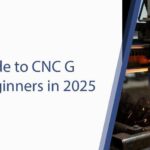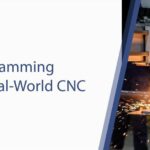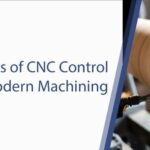CNC Technology and Machine Learning — The Future of Industrial Manufacturing
Industrial manufacturing is entering a new era where CNC (Computer Numerical Control) machines and Machine Learning (ML) technologies are merging to redefine how factories operate.
While CNC machines have long delivered precision, repeatability, and automation, machine learning now adds intelligence, adaptability, and predictive control.
By analyzing production data in real time, ML-powered CNC systems can optimize cutting paths, reduce tool wear, and detect anomalies before they affect output.
This synergy not only boosts productivity but also enables a shift toward smart, sustainable, and data-driven manufacturing — the foundation of Industry 4.0.

Understanding CNC Machines and Their Core Role in Manufacturing
CNC (Computer Numerical Control) machines are the backbone of modern industrial production. They use computer-guided commands to shape, cut, and process materials with exceptional precision — without manual intervention. This automation ensures high-speed production, consistent accuracy, and minimal human error.
Since their rise in the late 1950s, CNC machines have replaced many traditional manual operations, enabling manufacturers to scale efficiently and maintain quality standards across every production line. From milling and turning to engraving and drilling, CNC systems optimize each stage of the process by following programmed toolpaths and parameters.
Today, CNC machines are essential to industries such as jewelry, automotive, aerospace, and electronics, delivering accuracy, repeatability, and reliability at scale. However, while traditional CNC systems excel in precision, they still depend entirely on static programming — a limitation that machine learning aims to overcome.
Limitations of Traditional CNC Machines
Despite their precision and reliability, traditional CNC machines operate within a fixed framework. They rely on predefined programs and cannot adapt when unexpected variables occur — such as material inconsistencies, tool wear, or vibration changes. This rigidity limits their flexibility in dynamic production environments.
Because these machines execute only what is programmed, they cannot analyze, learn, or improve from real-time data. As a result, manufacturers may experience reduced efficiency, higher error rates, and costly downtime during complex or custom production runs.
This is precisely where Machine Learning (ML) introduces a breakthrough. By allowing CNC systems to learn from operational data, machine learning transforms them from static machines into adaptive, intelligent systems that continuously optimize performance and reduce the need for human intervention.

Enhancing CNC Performance with Machine Learning
The integration of Machine Learning (ML) into CNC technology marks a major leap toward intelligent automation. Every CNC machine generates a vast amount of data during production — from spindle speed and torque to vibration levels and cutting precision. When analyzed through ML algorithms, this data becomes the foundation for continuous improvement.
By learning from this information, CNC systems can:
-
Optimize cutting parameters to increase tool life and reduce material waste.
-
Detect anomalies such as tool wear or alignment drift in real time.
-
Adjust feed rates automatically, maintaining precision even under changing load conditions.
-
Predict and prevent quality issues, ensuring every part meets specification.
This ability to self-analyze and self-correct transforms traditional CNC systems into adaptive manufacturing units capable of making decisions on the fly. The result is higher throughput, fewer defects, and a smarter, data-driven production environment that evolves with each machining cycle.
Reducing Error Rates and Improving Precision in CNC Machines
In high-precision manufacturing, even the smallest deviation can cause costly rework or product rejection. Machine Learning (ML) helps eliminate these risks by allowing CNC machines to detect and correct issues before they affect quality.
Through advanced pattern recognition, ML algorithms analyze production data to spot early signs of deviation — such as spindle vibration, feed irregularities, or temperature shifts — and apply instant corrections. This predictive ability ensures continuous accuracy and minimizes waste.
Key Benefits of ML-Driven Error Reduction
-
Real-time anomaly detection: Identifies performance fluctuations before they cause defects.
-
Predictive calibration: Adjusts cutting parameters dynamically to maintain tolerance levels.
-
Quality forecasting: Learns from previous batches to anticipate and prevent future errors.
-
Maintenance insight: Detects patterns that may lead to mechanical faults or wear.
By learning from each production cycle, CNC systems become progressively more accurate, consistent, and efficient. Manufacturers gain higher-quality output, lower rejection rates, and a significant reduction in downtime and rework costs.
Improving CNC Maintenance with Predictive Analytics
Traditional maintenance models often wait for a failure to occur — leading to unplanned downtime, lost productivity, and high repair costs. With Machine Learning (ML) and predictive analytics, CNC machines can now anticipate failures before they happen.
By continuously monitoring data such as temperature, vibration, tool wear, and motor load, ML algorithms can identify early warning signs and alert operators in advance. This enables predictive maintenance, where service actions are scheduled based on actual machine conditions rather than fixed intervals.
Advantages of Predictive CNC Maintenance
-
Reduced downtime: Machines stay operational longer with fewer interruptions.
-
Lower maintenance costs: Resources are used efficiently, servicing only when needed.
-
Extended equipment life: Early interventions prevent major mechanical damage.
-
Improved production planning: Maintenance can be scheduled during low-demand periods.
Predictive analytics not only improves reliability but also creates a continuous feedback loop that helps CNC systems self-learn and adapt. Over time, this leads to smoother production lines, optimized performance, and greater overall equipment effectiveness (OEE) — key metrics in modern smart factories.

Opportunities for Robotic Integration
The integration of Machine Learning (ML) with CNC technology has unlocked powerful possibilities in robotic automation. Robots can now collaborate seamlessly with CNC machines, taking over repetitive or high-risk tasks such as material handling, tool changes, part loading, and unloading — all while maintaining precision.
Through ML algorithms, robots gain the ability to:
-
Recognize and adapt to different workpiece geometries.
-
Coordinate dynamically with CNC machines in real time.
-
Optimize movement patterns for efficiency and energy savings.
-
Perform error-free repetitive operations with minimal supervision.
This synergy between CNC machines, robotics, and ML accelerates automation, reduces production bottlenecks, and allows manufacturers to respond faster to changing demand — a cornerstone of Industry 4.0 smart factories.
Advancements in Quality Control and Customization
One of the most transformative outcomes of combining CNC and Machine Learning is in real-time quality control and mass customization.
CNC machines can now use integrated sensors, vision systems, and data analytics to inspect components as they are being produced, rather than after completion.
Machine Learning enables:
-
Instant defect detection using camera and sensor feedback.
-
Automated adjustments to maintain dimensional accuracy.
-
Personalized production based on historical design and tolerance data.
-
Reduced waste and rework, improving both sustainability and profitability.
This real-time intelligence empowers manufacturers to deliver consistent quality at scale while adapting quickly to custom or small-batch orders — all without sacrificing precision or speed.
Future Prospects of CNC and Machine Learning Integration
The relationship between CNC technology and Machine Learning is still evolving — and the potential is immense.
In the near future, CNC systems will feature self-learning controllers, cloud-based analytics, and edge AI that allow machines across global plants to learn collectively and share insights in real time.
Upcoming trends include:
-
Fully autonomous CNC systems capable of decision-making without human input.
-
Digital twins that simulate production scenarios to predict performance outcomes.
-
Edge-based machine learning for faster, on-site data processing.
-
Cross-factory optimization, where one CNC system’s learning benefits others worldwide.
These advancements will push industrial manufacturing toward hyper-efficiency, sustainability, and intelligent collaboration — redefining how factories think, operate, and innovate in the decades ahead.
Conclusion — Smarter CNC Systems, Smarter Manufacturing
The integration of CNC technology and Machine Learning (ML) marks a new era in industrial automation — and Radonix stands at the forefront of this transformation.
By merging advanced CNC control systems with intelligent learning algorithms, Radonix helps manufacturers move from traditional operation models to proactive, self-optimizing, and data-driven production.
This evolution delivers measurable advantages across every stage of manufacturing:
-
Higher productivity through automated process optimization.
-
Reduced downtime via predictive maintenance and diagnostics.
-
Superior precision and consistency with real-time quality analytics.
-
Greater sustainability through efficient resource management.
As ML continues to advance, Radonix CNC systems will keep empowering factories to think, adapt, and evolve — turning smart data into smarter manufacturing decisions.
With Radonix, innovation is not just engineered — it’s intelligently optimized for the future of global industry.
Contact Us:
- E-Mail: info@radonix.com
- Phone: +90 (553) 920 5500








